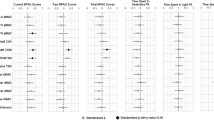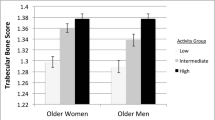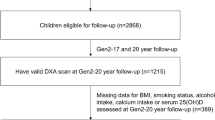Abstract
Summary
Relationships between objectively assessed free-living physical activity (PA) and changes in bone health over time are poorly understood in older adults. This study suggests these relationships are sex-specific and that body composition may influence the mechanical loading benefits of PA.
Introduction
To investigate associations of objectively assessed PA and bone health in community-dwelling older adults.
Methods
This secondary analysis of a subset of the Tasmanian Older Adult Cohort study included participants with PA assessed utilising ActiGraph GT1M accelerometers over 7 days (N = 209 participants, 53% female; mean ± SD age 64.5 ± 7.2 years). Steps/day and PA intensity were estimated via established thresholds. Bone mineral content (BMC) was acquired at the total hip, lumbar spine, legs and whole body by DXA at baseline and approximately 2.2 years later. Relationships between PA and BMC were assessed by multivariable linear regression analyses adjusted for age, smoking status, height and total lean mass.
Results
Men with above-median total hip BMC completed significantly less steps per day, but there was no significant difference in PA intensity compared with those with below-median BMC. There were no significant differences in PA in women stratified by median BMC. In women, steps/day were positively associated with leg BMC (B = 0.178; P = 0.017), and sedentary behaviour was negatively associated with leg BMC (− 0.165; 0.016) at baseline. After adjustment for confounders including lean mass and height, higher sedentary behaviour at baseline was associated with declines in femoral neck BMC (− 0.286; 0.011) but also with increases in pelvic BMC (0.246; 0.030) in men and increases in total hip BMC (0.215; 0.032) in women, over 2.2 years. No other significant longitudinal associations were observed after adjustment for body composition.
Conclusions
Associations of accelerometer-determined sedentary behaviour and PA with bone health in older adults differ by sex and anatomical site and are mediated by body composition.
Similar content being viewed by others
References
Australian Institute of Health and Welfare (2014) Estimating the prevalence of osteoporosis in Australia [Internet]. Canberra. Available from: http://www.aihw.gov.au/WorkArea/DownloadAsset.aspx?id=60129548481
Hannam KJ, Deere KC, Hartley A, Al-Sari UA, Clark EM, Fraser WD et al (2016) Habitual levels of higher, but not medium or low, impact physical activity are positively related to lower limb bone strength in older women: findings from a population-based study using accelerometers to classify impact magnitude. Osteoporos Int [Internet]. 28(10):2813–2822. Available from. https://doi.org/10.1007/s00198-016-3863-5
Warburton DER, Nicol CW, Bredin SSD (2006) Health benefits of physical activity: the evidence. CMAJ [Internet] 174(6):801–809. Available from: http://www.cmaj.ca/content/174/6/801
Goh VHH, Hart WG (2016) Aging, lifestyle factors, hormones and bone health in Singaporean men. Bone Reports [Internet] 5:110–116. Available from. https://doi.org/10.1016/j.bonr.2016.05.003
Lacombe J, Cairns BJ, Green J, Reeves GK, Beral V, Armstrong MEG (2016) The effects of age, adiposity, and physical activity on the risk of seven site-specific fractures in postmenopausal women. J Bone Miner Res 31(8):1559–1568
Adami S, Gatti D, Braga V, Bianchini D, Rossini M (1999) Site-specific effects of strength training on bone structure and geometry of ultradistal radius in postmenopausal women. J bone Miner Res [Internet] 14(1):120–124. Available from: http://www.ncbi.nlm.nih.gov/pubmed/9893073
Kelley GA, Kelley KS, Kohrt WM (2013) Exercise and bone mineral density in men: a meta-analysis of randomized controlled trials. Bone [Internet]. 53(1):103–111. Available from. https://doi.org/10.1016/j.bone.2012.11.031
James P, Weissman J, Wolf J, Mumford K, Contant CK, Hwang WT, Taylor L, Glanz K (2016) Comparing GPS, log, survey, and accelerometry to measure physical activity. Am J Health Behav 40(1):123–131
Ferguson T, Rowlands AV, Olds T, Maher C (2015) The validity of consumer-level, activity monitors in healthy adults worn in free-living conditions: a cross-sectional study. Int J Behav Nutr Phys Act [Internet] 12:42. Available from: http://apps.webofknowledge.com/full_record.do?product=UA&search_mode=GeneralSearch&qid=1&SID=2BbCoX5WP9gddPXAMX5&page=1&doc=9&cacheurlFromRightClick=no
Case MA, Burwick HA, Volpp KG, Patel MS (2015) Accuracy of smartphone applications and wearable devices for tracking physical activity data. J Am Med Assoc [Internet] 313(6):625. Available from: https://jamanetwork.com/journals/jama/fullarticle/2108876
Tudor-Locke C, McClain JJ, Hart TL, Sisson SB, Washington TL (2009) Pedometry methods for assessing free-living youth. Res Q Exerc Sport [Internet] 80(2):175–184. Available from: https://www.ncbi.nlm.nih.gov/pubmed/19650382
Koster A, Caserotti P, Patel KV, Matthews CE, Berrigan D, van Domelen DR et al (2012) Association of Sedentary time with mortality independent of moderate to vigorous physical activity. PLoS One 7(6):1–7
Gianoudis J, Bailey CA, Ebeling PR, Nowson CA, Sanders KM, Hill K, Daly RM (2014) Effects of a targeted multimodal exercise program incorporating high-speed power training on falls and fracture risk factors in older adults: a community-based randomized controlled trial. J Bone Miner Res 29(1):182–191
Johansson J, Nordstrom A, Nordstrom P (2015) Objectively measured physical activity is associated with parameters of bone in 70-year-old men and women. Bone [Internet] 81:72–79. Available from. https://doi.org/10.1016/j.bone.2015.07.001
Gerdhem P, Dencker M, Ringsberg K, Akesson K (2008) Accelerometer-measured daily physical activity among octogenerians: results and associations to other indices of physical performance and bone density. Eur J Appl Physiol 102(2):173–180
Gába A, Kapuš O, Pelclová J, Riegerová J (2012) The relationship between accelerometer-determined physical activity (PA) and body composition and bone mineral density (BMD) in postmenopausal women. Arch Gerontol Geriatr 54(3):e315–e321
Lee I, Ha C, Kang H (2016) Association of sarcopenia and physical activity with femur bone mineral density in elderly women. J Exerc Nutr Biochem [Internet] 20(1):23–28. Available from: https://www.ncbi.nlm.nih.gov/pubmed/27298809
Stillman R, Lohman T, Slaughter M, Massey B (1986) Physical activity and bone mineral content in women aged 30 to 85 years. Med Sci Sport Exerc 18(5):576–580
Trost SG, Mciver KL, Pate RR (2005) Conducting accelerometer-based activity assessments in field-based research. Med Sci Sports Exerc 37(11 SUPPL):S531–S543
Matthews CE, Hagströmer M, Pober DM, Bowles HR (2013) Best practices for using physical activity monitors. Med Sci Sports Exerc 44(18):1–17
Matthews CE (2005) Calibration for accelerometer output for adults. Med Sci Sport Exerc [Internet] S512(Supplement):S512–S522. Available from: http://www.scopus.com/inward/record.url?eid=2-s2.0-20544465741&partnerID=tZOtx3y1
Freedson PS, Melanson E, Sirard J (1998) Calibration of the Computer Science and Applications, Inc. accelerometer. Med Sci Sport Exerc. 30(5):777–781
Foley S, Quinn S, Jones G (2010) Pedometer determined ambulatory activity and bone mass: a population-based longitudinal study in older adults. Osteoporos Int 21(11):1809–1816
Allison SJ, Poole KES, Treece GM, Gee AH, Tonkin C, Rennie WJ, Folland JP, Summers GD, Brooke-Wavell K (2015) The influence of high-impact exercise on cortical and trabecular bone mineral content and 3D distribution across the proximal femur in older men: a randomized controlled unilateral intervention. J Bone Miner Res 30(9):1709–1716
Wallace BA, Cumming RG (2000) Systematic review of randomized trials of the effect of exercise on bone mass in pre- and postmenopausal women. Calcif Tissue Int 67(1):10–18
Lanyon LE, Rubin CT (1984) Static vs dynamic loads as an influences on bone remodelling. J Biomech 17(12):897–905
Vainionpää A, Korpelainen R, Sievänen H, Vihriälä E, Leppäluoto J, Jämsä T (2007) Effect of impact exercise and its intensity on bone geometry at weight-bearing tibia and femur. Bone 40(3):604–611
Hinton PS, Nigh P, Thyfault J (2015) Effectiveness of resistance training or jumping-exercise to increase bone mineral density in men with low bone mass: a 12-month randomized, clinical trial. Bone [Internet]. 79:203–212. Available from: http://linkinghub.elsevier.com/retrieve/pii/S8756328215002446
Rhodes EC, Martin AD, Taunton JE, Donnelly M, Warren J, Elliot J (2000) Effects of one year of resistance training on the relation between muscular strength and bone density in elderly women. Br J Sports Med [Internet] 34(1):18–22. Available from: https://www.ncbi.nlm.nih.gov/pmc/articles/PMC1724140/
Watson SL, Weeks BK, Weis LJ, Harding AT, Horan SA, Beck BR (2017) High-intensity resistance and impact training improves bone mineral density and physical function in postmenopausal women with osteopenia and osteoporosis: the LIFTMOR Randomized Controlled Trial. J Bone Miner Res [Internet]. Available from: http://doi.wiley.com/10.1002/jbmr.3284
Kohrt WM, Barry DW, Schwartz RS (2009) Muscle forces or gravity: what predominates mechanical loading on bone? Med Sci Sport Exerc. 41(11):2050–2055
Popp KL, McDermott W, Hughes JM, Baxter SA, Stovitz SD, Petit MA (2017) Bone strength estimates relative to vertical ground reaction force discriminates women runners with stress fracture history. Bone [Internet] 94:22–28. Available from. https://doi.org/10.1016/j.bone.2016.10.006
Chastin SFM, Mandrichenko O, Helbostadt JL, Skelton DA (2014) Associations between objectively-measured sedentary behaviour and physical activity with bone mineral density in adults and older adults, the NHANES study. Bone [Internet] 64:254–262. Available from. https://doi.org/10.1016/j.bone.2014.04.009
Gómez-Bruton A, González-Agüero A, Gómez-Cabello A, Matute-Llorente A, Casajús JA, Vicente-Rodríguez G (2016) Swimming and bone: is low bone mass due to hypogravity alone or does other physical activity influence it? Osteoporos Int [Internet] 27(5):1785–1793. Available from. https://doi.org/10.1007/s00198-015-3448-8
Deere KC, Hannam KJ, Coulson J, Ireland A, McPhee JS, Moss C et al (2016) Quantifying habitual levels of physical activity according to impact in older people: accelerometry protocol for the VIBE study. J Aging Phys Act 24(2):290–295
Ellis K, Kerr J, Godbole S, Staudenmeyer JW, Lanckriet G (2016) Hip and wrist accelerometer algorithms for free-living behavior classification. Med Sci Sports Exerc 48(5):933–940
Do K, Treloar SA, Pandeya N, Purdie D, Green C, Heath AC et al (1998) Predictive factors of age at menopause in a large Australian twin study. Hum Biol 70(6):1073–1091
Australian Bureau of Statistics (2006) National Health Survey: summary of results [Internet]. Canberra. Available from: http://www.ausstats.abs.gov.au/Ausstats/subscriber.nsf/0/3B1917236618A042CA25711F00185526/$File/43640_2004-05.pdf
Acknowledgements
We gratefully acknowledge the efforts of the TASOAC participants and staff, particularly study coordinator Catrina Boon. DS, GJ and DA wish to acknowledge fellowship support from the National Health and Medical Research Council of Australia. LBM was supported by an Australian Postgraduate Award.
Funding
This work was supported by the National Health and Medical Research Council of Australia, Arthritis Foundation of Australia, Tasmanian Community Fund, and University of Tasmania Institutional Research Grants Scheme.
Author information
Authors and Affiliations
Corresponding author
Ethics declarations
Conflicts of interest
None.
Ethical approval
All procedures performed in this study involving human participants were in accordance with the ethical standards of the institutional research committee and with the 1964 Helsinki declaration and its later amendments or comparable ethical standards. Written informed consent was obtained from all participants.
Additional information
Graeme Jones and David Scott are joint senior authors.
Rights and permissions
About this article
Cite this article
McMillan, L.B., Aitken, D., Ebeling, P. et al. The relationship between objectively assessed physical activity and bone health in older adults differs by sex and is mediated by lean mass. Osteoporos Int 29, 1379–1388 (2018). https://doi.org/10.1007/s00198-018-4446-4
Received:
Accepted:
Published:
Issue Date:
DOI: https://doi.org/10.1007/s00198-018-4446-4




